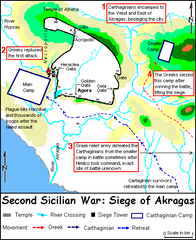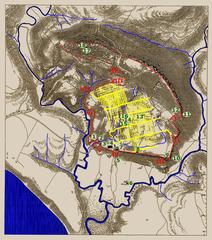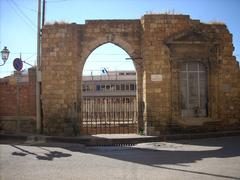Comprehensive Guide to Visiting Chiesa di Santa Maria dei Greci, Agrigento, Italy
Date: 23/07/2024
Introduction
Nestled in the heart of Agrigento, Sicily, the Chiesa di Santa Maria dei Greci is a beacon of the island’s rich and multifaceted history. This extraordinary church, standing on the remnants of a 5th-century BCE Doric temple, is a testament to the diverse cultural influences that have shaped Sicily over millennia. From Greek, Byzantine, and Arab to Norman and Baroque, each era has left its indelible mark on this architectural marvel. Originally built as a temple dedicated to Athena in the ancient Greek city of Akragas, the site has undergone numerous transformations, reflecting the island’s shifting religious and cultural paradigms. The church’s name, “Santa Maria dei Greci,” underscores its Byzantine roots, having served the Greek Orthodox community during the Byzantine period (Sicily Heritage). Today, Chiesa di Santa Maria dei Greci is not only a place of worship but also a symbol of Agrigento’s rich cultural tapestry, drawing visitors from around the globe to explore its unique blend of Doric, Gothic, and Baroque architectural elements (Agrigento Tourism). This guide aims to provide comprehensive information on the church’s history, visiting hours, ticket prices, and travel tips to help you make the most of your visit.
Table of Contents
- Introduction
- History of Chiesa di Santa Maria dei Greci
- Visitor Information
- Significance in Contemporary Culture
- Conclusion
- FAQ
History of Chiesa di Santa Maria dei Greci
Origins and Early History
The Chiesa di Santa Maria dei Greci, located in Agrigento, Italy, is a remarkable example of the layered history that characterizes much of Sicily. The church’s origins date back to the 5th century BCE when it was initially constructed as a Doric temple dedicated to Athena. This ancient temple was part of the larger Greek city of Akragas, one of the most important and affluent cities in Magna Graecia. The remnants of the original temple can still be seen today, particularly in the form of the Doric columns that are integrated into the church’s structure (Agrigento Tourism).
Byzantine and Arab Periods
During the Byzantine period, the temple was converted into a Christian church, reflecting the widespread Christianization of the Roman Empire. This transformation involved significant architectural modifications, including the addition of a basilica layout. The church’s name, “Santa Maria dei Greci,” or “Saint Mary of the Greeks,” is a testament to its Byzantine heritage, as it was used by the Greek Orthodox community in Agrigento (Sicily Heritage).
In the 9th century, Sicily fell under Arab control, and the church was repurposed as a mosque. This period saw the introduction of Islamic architectural elements, although many of these were later removed or altered when the Normans reconquered Sicily in the 11th century. The Arab influence, however, left an indelible mark on the cultural and architectural landscape of the region (Arab-Norman Palermo).
Norman Conquest and Medieval Period
The Norman conquest of Sicily in the 11th century marked another significant chapter in the history of Chiesa di Santa Maria dei Greci. The Normans, who were fervent supporters of the Latin Church, reconverted the mosque back into a Christian church. They undertook extensive renovations, blending Norman architectural styles with the existing Byzantine and Arab elements. This period also saw the construction of the church’s distinctive bell tower, which remains a prominent feature today (Norman Sicily).
During the medieval period, the church continued to serve as a vital religious and community center. It was during this time that the church acquired many of its current features, including the Gothic-style arches and the intricate frescoes that adorn its interior. These additions reflect the evolving architectural tastes and religious practices of the period (Medieval Sicily).
Renaissance and Baroque Transformations
The Renaissance period brought further changes to Chiesa di Santa Maria dei Greci. The church underwent significant renovations to align with the Renaissance aesthetic, which emphasized symmetry, proportion, and the use of classical elements. This period saw the addition of several chapels and altars, as well as the installation of new artwork and sculptures. The influence of Renaissance humanism is evident in the church’s design, which sought to harmonize the ancient and medieval elements with contemporary tastes (Renaissance Art in Sicily).
In the 17th century, the Baroque style became predominant in Sicily, and Chiesa di Santa Maria dei Greci was not immune to this trend. The church was adorned with elaborate stucco decorations, ornate altarpieces, and dramatic frescoes that exemplified the Baroque fascination with movement, contrast, and theatricality. These additions enhanced the church’s visual impact and reflected the Counter-Reformation’s emphasis on art as a means of inspiring faith and devotion (Baroque Sicily).
Modern Era and Preservation Efforts
The 19th and 20th centuries saw a renewed interest in preserving and restoring Chiesa di Santa Maria dei Greci. Archaeological excavations revealed more about the church’s ancient origins, leading to efforts to protect and showcase its historical layers. These efforts included the stabilization of the ancient Doric columns and the restoration of the medieval frescoes, ensuring that the church’s rich history could be appreciated by future generations (Modern Preservation).
In recent years, the church has become a focal point for both religious and cultural tourism in Agrigento. It stands as a testament to the city’s diverse historical influences, from its Greek and Byzantine roots to its Arab, Norman, and Baroque transformations. Visitors to Chiesa di Santa Maria dei Greci can explore its unique architectural features, including the blend of Doric, Gothic, and Baroque elements, and gain insight into the complex history of Sicily itself (Agrigento Tourism).
Visitor Information
Visiting Hours
The church is open to visitors from Monday to Saturday, 9:00 AM to 6:00 PM, and on Sunday from 1:00 PM to 5:00 PM. It’s advisable to check the official website or contact the church directly for any changes in visiting hours, especially during holidays and special events.
Tickets
Admission to Chiesa di Santa Maria dei Greci is €6 for adults, €4 for seniors and students, and free for children under 12. Tickets can be purchased at the entrance or online through the church’s official website.
Accessibility
The church is wheelchair accessible, with ramps and elevators available for visitors with mobility issues. However, some areas with ancient ruins may have limited access.
Travel Tips
Agrigento is well-connected by public transport, with regular buses and trains from major Sicilian cities. The church is located in the historic center, so consider wearing comfortable shoes for walking. Guided tours are available and can provide deeper insights into the church’s history and architecture.
Nearby Attractions
While in Agrigento, don’t miss the Valley of the Temples, a UNESCO World Heritage site featuring some of the best-preserved ancient Greek ruins. The Agrigento Archaeological Museum and the Scala dei Turchi, a stunning white cliff on the coast, are also worth visiting.
Significance in Contemporary Culture
Today, Chiesa di Santa Maria dei Greci is not only a place of worship but also a symbol of Agrigento’s rich cultural heritage. It hosts various religious ceremonies, cultural events, and educational programs aimed at promoting an understanding of the region’s history. The church’s preservation and continued use underscore the importance of maintaining historical sites as living parts of the community, bridging the past and present (Cultural Significance).
Conclusion
In summary, the history of Chiesa di Santa Maria dei Greci is a microcosm of the broader historical currents that have shaped Sicily. From its origins as a Greek temple to its transformations under Byzantine, Arab, Norman, and Baroque influences, the church embodies the island’s complex and multifaceted heritage. Its preservation and continued relevance highlight the enduring importance of historical sites in understanding and appreciating our shared past. Whether you’re a history enthusiast or a casual traveler, a visit to Chiesa di Santa Maria dei Greci offers a unique glimpse into the rich cultural tapestry of Agrigento.
FAQ
What are the visiting hours of Chiesa di Santa Maria dei Greci?
The church is open from Monday to Saturday, 9:00 AM to 6:00 PM, and on Sunday from 1:00 PM to 5:00 PM.
How much do tickets cost?
Tickets are €6 for adults, €4 for seniors and students, and free for children under 12.
Is the church wheelchair accessible?
Yes, the church is wheelchair accessible, with ramps and elevators available.
What are some nearby attractions?
Nearby attractions include the Valley of the Temples, the Agrigento Archaeological Museum, and the Scala dei Turchi.
References
- Agrigento Tourism. (n.d.). Retrieved from Agrigento Tourism
- Sicily Heritage. (n.d.). Retrieved from Sicily Heritage
- Arab-Norman Palermo. (n.d.). Retrieved from Arab-Norman Palermo
- Norman Sicily. (n.d.). Retrieved from Norman Sicily
- Medieval Sicily. (n.d.). Retrieved from Medieval Sicily
- Renaissance Art in Sicily. (n.d.). Retrieved from Renaissance Art in Sicily
- Baroque Sicily. (n.d.). Retrieved from Baroque Sicily
- Modern Preservation. (n.d.). Retrieved from Modern Preservation
- Cultural Significance. (n.d.). Retrieved from Cultural Significance





